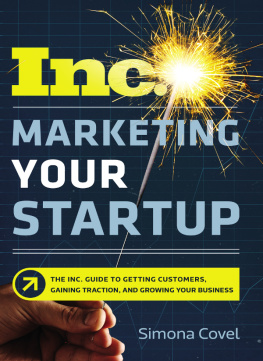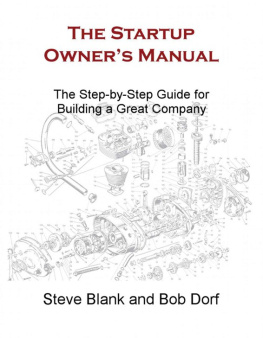Penguin supports copyright. Copyright fuels creativity, encourages diverse voices, promotes free speech, and creates a vibrant culture. Thank you for buying an authorized edition of this book and for complying with copyright laws by not reproducing, scanning, or distributing any part of it in any form without permission. You are supporting writers and allowing Penguin to continue to publish books for every reader.
While the author has made every effort to provide accurate telephone numbers, Internet addresses, and other contact information at the time of publication, neither the publisher nor the author assumes any responsibility for errors or for changes that occur after publication. Further, the publisher does not have any control over and does not assume any responsibility for author or third-party Web sites or their content.
Preface: Traction Trumps Everything
I n 2006 I sold for millions of dollars an Internet company that I had cofounded a few years earlier. It was a strange company for many reasons, not the least of which was that we had no employees from beginning to end. I wrote every line of code and did all the accounting and customer support.
The terms of the deal were such that my cofounder and I didnt have to work for the acquiring company at all. We were free to move on to other things, and we did. A few months later my wife and I moved from our 865-square-foot apartment near Boston to a country house twenty-five miles outside of Philadelphia. I had just turned twenty-seven.
She went to her job and I sat at home doing nothing for the first time in my life. We knew no one for a hundred miles in any direction.
Naturally, I started tinkering on the computer again, starting about a dozen side projects simultaneously. A year and a half later, I thought I was on to something. I noticed two things that bothered me about Google: too much spam (all those sites with nothing but ads) and not enough instant answers (I kept going to Wikipedia and IMDb). I thought if I could easily pick out the spam and the answers, then Id have a more compelling search engine.
Both problems were harder to solve than I initially thought, but I thoroughly enjoyed the work and kept at it. Everyone I talked to about my search engine project thought I was nuts. Youre doing what? Competing against Google? Why? How? Another year later, in the fall of 2008, I flipped the switch, unveiling my search engine to the public.
DuckDuckGo had a rather uneventful launch, if you can even call it a launch. I posted it to a niche tech site called Hacker News and that was the long and short of it. The post was entitled What do you think of my new search engine?
Like many entrepreneurs, Im motivated by being on the cusp of something big, and I was at the point where I needed some validation. I can survive on little, but I needed something.
I got it.
Granted, the product wasnt anything youd want to switch to at that point, and people let me know that. It was an Internet forum, after all. However, I still felt there was genuine interest in a new search competitor. I could tell some people were growing wary of what Google was becoming. For example, those initial conversations led me to investigate search privacy and eventually become the search engine that doesnt track you, years before government and corporate surveillance became a mainstream issue.
In any case, the response I received was enough motivation to keep me going. Which brings me to traction. I needed some.
Traction is the best way to improve your chances of startup success. Traction is a sign that something is working. If you charge for your product, it means customers are buying. If your product is free, its a growing user base.
Traction is powerful. Technical, market, and team risks are easier to address with traction. Fund-raising, hiring, press, partnerships, and acquisitions all become much easier.
In other words, traction trumps everything.
My last startup had grown using two traction channels: first, search engine optimization (ranking high in search engines for relevant terms), and later, viral marketing (where your customers bring in other customers, such as by referring friends and family through use of the product).
Viral marketing doesnt work well in search because you cant easily bake it into the product by putting stuff between people and their search results. So I tried search engine optimization. The terms search engine and search engines were too hard to rank for, as the high-ranking companies had been around for a decade and had tens of thousands of links pointing at them from their long histories. New search engine was more in my grasp.
I worked hard for many months to rank high for this phrase. The key to good search engine optimization (SEO) is getting links. As you will read later in the SEO chapter, you need a strategy to get these links in a scalable way.
Getting stories written about you in blogs and news outlets is a common SEO linking strategy. However, I hit saturation with that channel strategy pretty quickly and it didnt get me to the top. Something more creative was required.
After much brainstorming and experimenting, I eventually hit upon a good idea. I built a karma widget that would display links to your social media profiles and how many followers you had on each service. People would embed it on their sites and at the bottom there would be a link back to DuckDuckGo that said new search engine.
This channel strategy worked beautifully. I was number one.
Trouble was, not a ton of people make that searchabout fifty a day. So while I did get some traction and a steady stream of new users, it leveled off pretty quickly. It wasnt enough traction to be meaningful. It didnt move the needle.
I made two large traction mistakes here. First, I failed to have a concrete traction goal. In retrospect, to move the needle for my traction goals at the time, I needed more like five thousand new visitors a day, not fifty. Search engine optimization was not going to get me there.
Second, I was biased by my previous experience. Just because my last company got traction in this way didnt mean it was right for every company.
These are very natural mistakes to make. In fact, most startups make them. The most common startup trajectory now goes something like the following:
Founders have an idea for a company theyre excited about. Initial excitement turns into a struggle to build a product, but they do get something out the door.
Launch!
The founders expected customers to beat a path to their door, but unfortunately that isnt happening. Getting traction was an afterthought, but now they are focused on it. They try what they know or what theyve heard others do: some Facebook ads, a little local PR, and maybe a smattering of blog posts.
Then they run out of money and the company dies.
Sadly, this is the norm. Even sadder, often these products are actually on to something. That is, with the right traction strategy they might have actually been able to get traction and not go out of business.
Given my previous startup success I thought I knew what I was doing. I was wrong. Luckily, I wasnt dead wrong. I had the money to self-fund through my traction mistakes, and so they didnt prove fatal for DuckDuckGo. Not everyone is as lucky.












